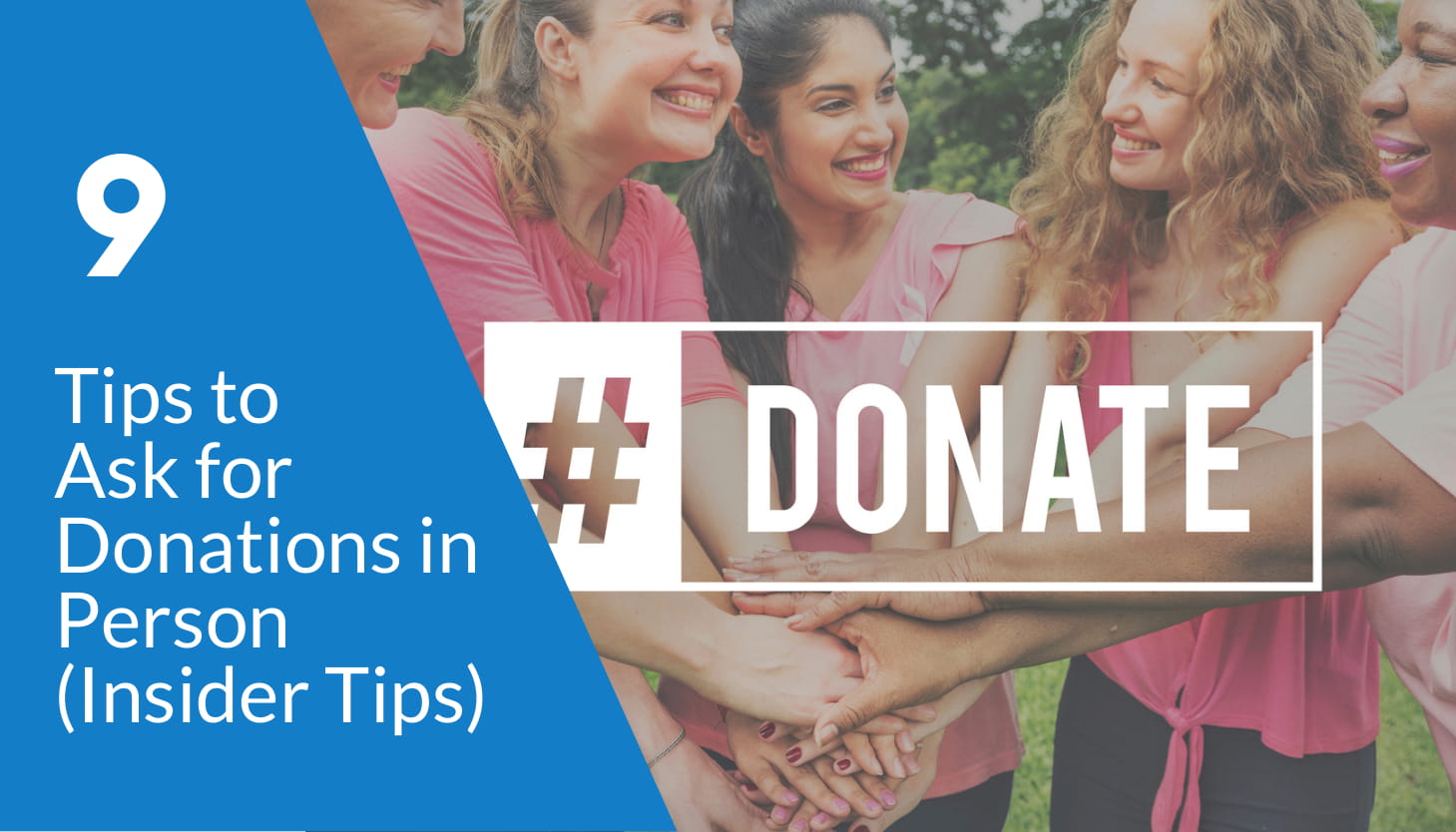When it comes to fundraising and all the challenges it entails in its various forms, most fundraisers would agree there’s nothing more gut-wrenching than asking for donations in person.
While it’s certainly difficult to make the ask for donations via email or on the phone too; there’s something particularly nerve-wracking about asking for donations in person.
The in-person ask for donations, however, has many advantages over other fundraising methods.
Why is it so?
There could be many reasons, but fundraising experts often boil it down to this:
- Meeting in person helps the fundraiser build a relationship with the prospective donor in a way that no other fundraising method can.
- 1:1 interaction allows for a personalized approach.
- Agreeing to meet in person is already an indicator that the prospective donor is interested in giving.
- It’s harder to say “no” in person.
Having said that, asking for donations, that too in person is an art that takes time to learn.
Here are 9 Tips & Best Practices for asking for donations in person or improving your in-person donation appeals:
- Get the Basics Right
- Research, Research, Research
- Prepare your Pitch
- Practice Makes Perfect
- Stay Mindful of your Attitude
- Become Okay with Rejection
- Be Interested
- Actually Ask
- Say Thank You
1. Get the Basics Right
Don’t go into in-person donation request for fundraising with blindfolds on, potentially wasting precious organizational resources that could be better spent elsewhere.
First, clarify the overall context. Take time to review your organization’s mission, vision, and goals. Follow that by looking at your fundraising as a whole. What are you hoping to achieve with your fundraising? What is your overall goal? Who will benefit from your fundraising?
How much do you need to fundraise or how many donors do you need to acquire?
Review your previous fundraising campaigns, as well as your past results. This will help you set realistic goals.
Also create a detailed outlook of the costs associated with your campaign: financial, allocated staff time, advertising/promotion costs, vendor contracts, startup costs, etc. Leave room in your budget for innovation and agility in the face of the unforeseen. Think about staff members and their skillset.
This will help you get the basics right, ensure that an in-person fundraising campaign makes sense for your nonprofit, and help define its scope.
Marc A. Pitman shares on fundraisingcoach.com: “One of the most helpful tools is a gift grid. A free online version can be found at GiftRangeCalculator.com. Long-standing common wisdom shows that you’ll need at least one gift equalling 10% of the total. The next two should equal 5% of the total, etc. So, to reach your goal of $100,000, you’ll need at least one donor to give a minimum of $10,000. Experience shows that you’ll need to have 4 or 5 prospects to achieve that gift. Work through the grid until you have names of prospects for each level.”
Read more about how to set and meet fundraising goals here.
2. Research, Research, Research
Before suiting up and getting your best ‘small talk’ game on, it’s vital that you do research before you go ahead and ask for donations.
Build your prospect list. Start by adding those you know to the list – for example, board members and their networks. Make a list of people and companies. Start with ones that you suspect have the capacity, are philanthropic, and/or interested.
Then, do some research on the individuals, major gift donors, or companies that you added to your prospect list. Using a wealth screening software, understand if they are financially able to give to your nonprofit, and if so, how much? Do they have a history of giving, as in volunteer grants or other donations? If so, which organizations have they given to and how much? Do they know about your organization and/or are they interested in social causes like yours?
Based on that research, and you could even score each prospect, prioritize your efforts.
Also, once you have the top 10/50/100 prospects (the number will depend on the size of your organization), research those top prospects even more deeply. Learn as much as possible about them by reading their blogs, biographies, or interviews. You must try and make the donation appeal as relevant and personalized as possible.

3. Prepare Your Pitch
Great in-person fundraising isn’t about rehearsing a presentation or learning a speech by heart.
However, it helps to know your own case, your value proposition. Being very clear about why it is that your organization’s work matters, why it’s unique, and why someone should be interested in giving to you can come in handy during a meeting when nerves kick in.
While people give emotionally, they still use concrete information to back up big decisions (and in-person fundraising is often aimed at major gifts).
So, talk about how you are changing the lives of your beneficiaries. Select a single story or more success stories to paint the picture of your impact, and then share the numbers.
For example:
“Anna graduated from our program one year ago. Today she is sober and runs a successful flower shop.
She’s only one of the hundreds of young people in Portland we helped – 800 just this past year to be exact.”
Consider sharing a brief explanation of any existing strategic partnerships as well.
From the research you’ve done, pull up information so that you can tailor your donation request to the prospect, enabling them to relate to it better.
Finally, asking for donations in person is a conversation. Never let your ‘prepared’ information or pitch take the center stage. Conversations are fluid, so listen actively and go with the flow. Adapt and change how and what you say depending on what your prospect is sharing with you. Be open to questions from them as you go on with your donation request pitch.
4. Practice Makes Perfect (Or At Least Great)
Nothing new and exciting here. The wisdom that’s almost ancient: practice makes perfect. Or at least great. By the time you’re sitting in front of a prospect, you should have practiced your pitch and polished your skills.
Understand your talking points and your main value propositions. List the most common objections you think you could receive and practice addressing them. Decide how you’ll frame the ask for donations when it comes to it. With these in mind, you’ll be able to be more focused and present during the meeting with your prospect.
Ask your colleagues for feedback. Read up on negotiation, sales, nonverbal and verbal communication, and persuasion.
Practice in front of a mirror or with family members and friends. Record yourself and then watch the recording back, taking note on things you could improve before finally asking for donations.

5. Stay Mindful of Your Attitude
When asking for donations in person, unlike with other fundraising methods, the prospect will be impacted by how you come across as a person.
Pay special attention to your body language and your voice. Sit straight but relaxed, face your prospect. Use movement to generate interest while asking for donations.
Vary the tempo, pitch, and tone of your voice. Reflect back to your prospect, for example by matching body language and using similar verbal style, in order to create an emotional bond with them.
Clear body language is relaxed and precise, without being held in or under control. It supports speech, for example in emphasizing key points, and never contradicts it.
Finally, positive attitude matters in fundraising. If you go into a meeting assuming you will get a no, you probably will. Go to meetings expecting a yes and asking for a yes.
6. Become Okay With Rejection
While it’s vital that you maintain a positive attitude and expect a yes when you ask for donations in person, it’s also important that you’re prepared for a “no”.
This doesn’t mean you should expect a “no”, just be ready in case a “no” is what you get.
Entrepreneurs, salespeople, and fundraisers all need to cultivate a good dose of grit and persistence if they are to succeed.
Fundraising, like sales, is often about keeping it up and staying motivated after 10 “no’s” until there’s a single “yes”.
Even when you get “no” as an answer when asking for donations, always thank your prospect for their time. Always seek to understand why they said “no”, and if appropriate, ask them for feedback about how you handled the meeting. Take that input on board and keep refining your ask for donations.
Furthermore, ask them when would be a good time to touch base again and re-evaluate the situation. Keep in contact with them, but respect their wishes and be careful not to pester them. Share with them your social media account details, your contact number, etc. and ask them to reach out anytime they have a query about your work. Your amiable attitude will certainly win their hearts.

7. Be Interested
Anyone who has ever succeeded in their donation appeal requests and fundraising efforts was able to build meaningful relationships. And there are no building meaningful relationships without being interested in the other person.
From your research, have a couple of questions ready. Perhaps ask your prospect about their career, their future plans, and projects, things they care about. Also, listen without interrupting and then ask questions that show you listened.
When listening for long stretches, concentrate on, and remember keywords and phrases.
When it’s your turn to listen, don’t spend the time planning what to say next. If you don’t understand something, of course, you should ask the speaker to explain it to you. But rather than interrupt, wait until the speaker pauses.
To act with empathy, you have to put yourself in the other person’s place and allow yourself to feel what it is like to be them at that moment.
Show that you understand where the speaker is coming from by reflecting the speaker’s feelings. “You must be excited!” “That must have been difficult.” “I can see that you are on the fence.” Nod occasionally. Smile and use other facial expressions. Make sure that your posture is open and interested.
Pro tip: Become okay with silence. Most of us are incredibly uncomfortable with silence and will go to great lengths just to keep the conversation going. However, pausing after saying something or acknowledging something the prospect had said gives them the space to share more. This, in turn, provides you with valuable input and information that you can then use to guide the conversation forward.
8. Actually Ask for Donations
You’ve done everything… You researched, you set up the meeting, you chatted, you shared some of the work you’ve been doing. The moment has arrived. And you panic; you have no idea how to actually ask for donations. At this point, it’s very tempting to keep it vague. Vague is more comfortable.
You might ask: “I was wondering if you would support our work,” or “We’d love your help with this new project.” However, “help” and “support” are not specific enough and mean different things to different people.
Instead, ask:
“Would you consider a gift of $10,000?”
Always ask for a specific donation amount to contribute to the cause. Don’t make your donor do the guesswork. Take the burden off them.
Potentially even tie the gift to a very specific outcome.
Here’s an example Joan Garry shared on her blog:
“Would you make a gift of $489? Odd number I know but it happens to be the number of calls that came into our help desk last week. Can I count on you?”
If fear kicks in, remember that people feel good donating to causes they care about and that you’re coming up with means to support programs and projects that change the world!
Have an online donation page ready with these suggested gift amounts and possible impact details. Share this donation page link with your donor or open it on your laptop or tablet during the conversation. Show them what each amount means for your nonprofit organization and help them make the decision.
Your online donation form, donation page or fundraising page must be on-brand and include real images from your organization’s work to instill a sense of trust in your donors. Also ensure that the page includes your social media account details to help them connect with you afterward.

9. Say Thank You
Whether the donor gives or not, your work is not over! Make sure you communicate how much you appreciate their contribution or their time.
Genuinely thank them in person and continue the discussion, if appropriate.
Send a personalized, handwritten thank you email or letter after the donation has been made. Stay in touch with the donor via phone, email, and social media. Highlight your donors in your annual report or somewhere on your website (ask for permission first). Those who have given, collect their social media account IDs and tag them there to acknowledge their gifts via a social media post.
You can also add a virtual donor wall to your donation pages. It highlights donors’ donations and their names. This also works well as a social proof for others checking out your donation page.
Invite the donor to your offices to meet the staff, invite them to events, and continue to meet in person when possible to thank them for their support.
By doing this, you’ll be demonstrating your appreciation and showing your donor you value their contribution. By maintaining and deepening the relationship with the donor, you show them they’re more than a wallet to you.
And when donors feel recognized, they feel invited to contribute more and for longer too! And they’re likely to bring others on board too.
Other Tips to Help You Ask for Donations in Person
- Use props (photos, business cards, brochures, a video or even graphs) to add credibility and interest.
- If they say “no”, offer other ways to help. Ask them if they know anyone who might be able to contribute now or ask them to share your nonprofit on social media.
- Slow down and take deeper breaths, especially if you’re nervous.
- Use a quote from someone who benefits from your services.
- When telling a story about a beneficiary, include identifying details like their name, job, or hobbies, to help potential donors get to know the person and connect to them.
- Before ever asking for donations, consider first inviting your prospect to talk and learn more about your cause and volunteer opportunities.
- Make it easy for your donor base to make donations online. As you ask for a donation, share multiple ways they can donate online.
Over To You
There is an art to ask for donations in person. Sending a fundraising letter or a fundraising email can be easier or a more comfortable option for some but in-person asks leave a lasting impression. While it’s true that some fundraisers seem to be more naturally great at soliciting donations in person than others, to become a great fundraiser, you have to spend years learning and perfecting your craft.
Asking for donations takes overcoming a fear of rejection, of failing, of not being good enough. It takes a willingness to fail and the courage to keep trying again. It asks for an outstanding willingness to learn while you’re constantly looking for what works. It takes finding your own authentic fundraising style. And finally and perhaps most importantly, it takes love for what your organization is doing in the world!
Follow the above tips and best practices to get better at your donation requests.
At Donorbox, we strive to make your nonprofit experience as productive as possible, whether through our online donation system or through resources on our nonprofit blog.








